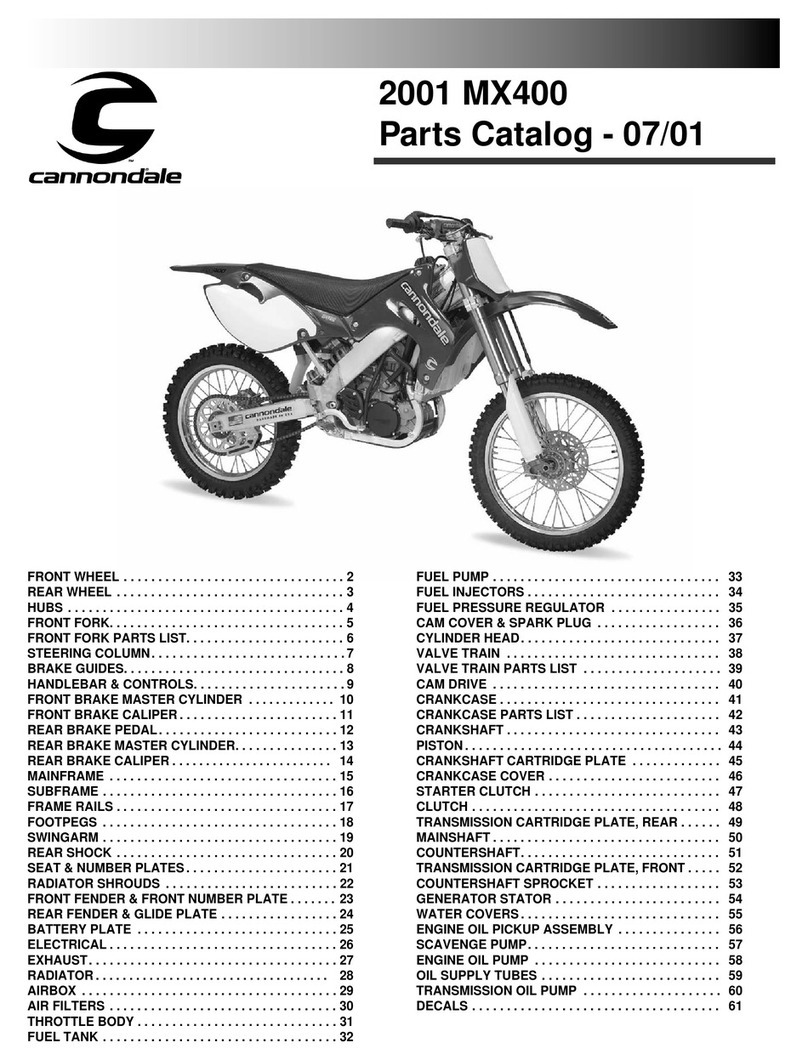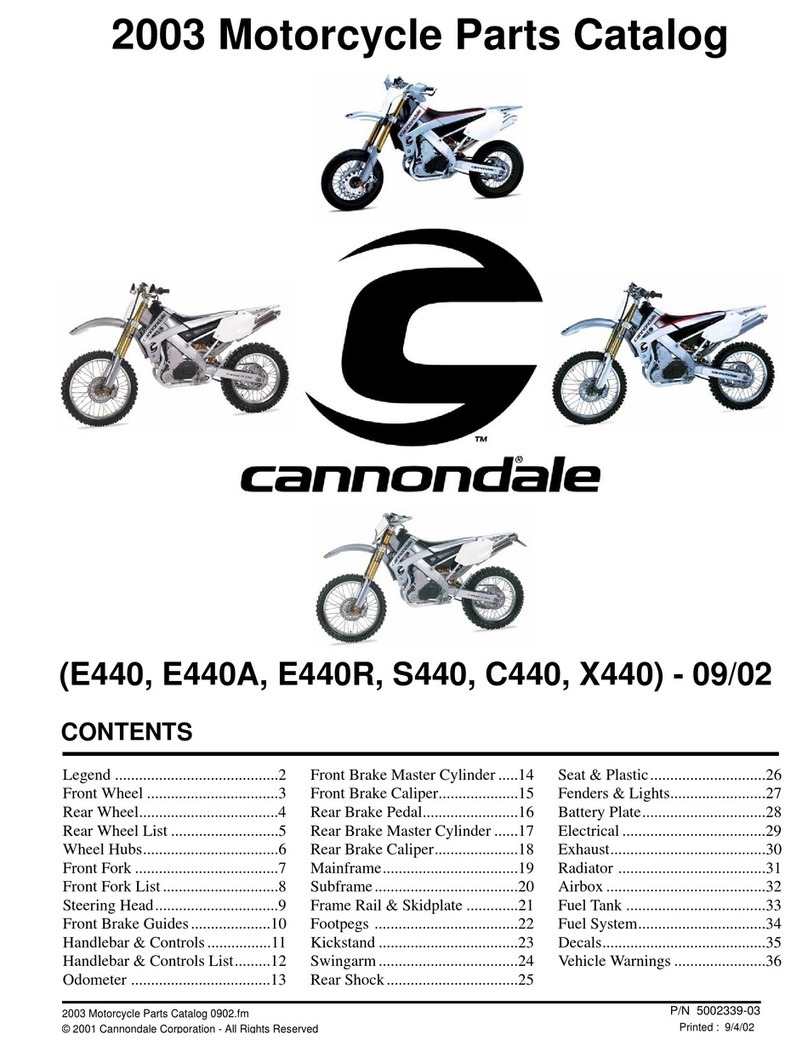5Printed : 1/9/02
5
CONTENTS
SAFETY ALERTS . . . . . . . . . . . . . . . . . 2
CONTENTS . . . . . . . . . . . . . . . . . . . . . . 5
IMPORTANT INFORMATION . . . . . . . . 6
About this manual . . . . . . . . . . . . . . . . . . . . . . . 6
How to use this manual. . . . . . . . . . . . . . . . . . . 6
Experienced riders only. . . . . . . . . . . . . . . . . . . 7
Exercise good judgement . . . . . . . . . . . . . . . . . 7
Modifications . . . . . . . . . . . . . . . . . . . . . . . . . . . 7
No passengers . . . . . . . . . . . . . . . . . . . . . . . . . 7
Aluminum chassis components. . . . . . . . . . . . . 8
VEHICLE LABELING . . . . . . . . . . . . . 10
MACHINE IDENTIFICATION. . . . . . . . 12
Vehicle Identification Number (VIN) . . . . . . . . 12
Engine Serial Number. . . . . . . . . . . . . . . . . . . 12
PARTS & CONTROLS . . . . . . . . . . . . 13
Engine start button . . . . . . . . . . . . . . . . . . . . . 13
Engine stop button . . . . . . . . . . . . . . . . . . . . . 13
Lighting switch. . . . . . . . . . . . . . . . . . . . . . . . . 14
Headlight. . . . . . . . . . . . . . . . . . . . . . . . . . . . . 15
Taillight . . . . . . . . . . . . . . . . . . . . . . . . . . . . . . 15
Fuses . . . . . . . . . . . . . . . . . . . . . . . . . . . . . . . 16
Optional lighting . . . . . . . . . . . . . . . . . . . . . . . 16
Multi-function ride computer . . . . . . . . . . . . . . 17
Clutch lever . . . . . . . . . . . . . . . . . . . . . . . . . . . 17
Shift lever . . . . . . . . . . . . . . . . . . . . . . . . . . . . 17
Throttle grip. . . . . . . . . . . . . . . . . . . . . . . . . . . 18
Front brake lever. . . . . . . . . . . . . . . . . . . . . . . 19
Footpegs . . . . . . . . . . . . . . . . . . . . . . . . . . . . . 20
Rear brake pedal. . . . . . . . . . . . . . . . . . . . . . . 20
Side stand or kickstand. . . . . . . . . . . . . . . . . . 21
Handguards. . . . . . . . . . . . . . . . . . . . . . . . . . . 22
Fuel cap . . . . . . . . . . . . . . . . . . . . . . . . . . . . . 23
FLUIDS . . . . . . . . . . . . . . . . . . . . . . . . 24
Fuel . . . . . . . . . . . . . . . . . . . . . . . . . . . . . . . . . 24
Brake fluid . . . . . . . . . . . . . . . . . . . . . . . . . . . . 25
Front brake . . . . . . . . . . . . . . . . . . . . . . . . . . . 25
Rear brake . . . . . . . . . . . . . . . . . . . . . . . . . . . 26
Engine oil . . . . . . . . . . . . . . . . . . . . . . . . . . . . 27
Transmission oil . . . . . . . . . . . . . . . . . . . . . . . 34
Coolant . . . . . . . . . . . . . . . . . . . . . . . . . . . . . . 37
Hydraulic clutch oil . . . . . . . . . . . . . . . . . . . . . 39
PRE-RIDE INSPECTION. . . . . . . . . . . 41
Pre-ride checklist. . . . . . . . . . . . . . . . . . . . . . . 41
OPERATION . . . . . . . . . . . . . . . . . . . . 42
Cold starting . . . . . . . . . . . . . . . . . . . . . . . . . . 42
Starting a warm engine . . . . . . . . . . . . . . . . . .42
Jump starting . . . . . . . . . . . . . . . . . . . . . . . . . .42
Shifting gears. . . . . . . . . . . . . . . . . . . . . . . . . .43
Braking. . . . . . . . . . . . . . . . . . . . . . . . . . . . . . .43
Post ride checks. . . . . . . . . . . . . . . . . . . . . . . .43
Break-In . . . . . . . . . . . . . . . . . . . . . . . . . . . . . .44
MAINTENANCE SCHEDULE. . . . . . . 45
Maintenance record. . . . . . . . . . . . . . . . . . . . .47
MAINTENANCE & ADJUSTMENT . . 48
Seat . . . . . . . . . . . . . . . . . . . . . . . . . . . . . . . . .48
Fuel . . . . . . . . . . . . . . . . . . . . . . . . . . . . . . . . .50
Brakes . . . . . . . . . . . . . . . . . . . . . . . . . . . . . . .55
Clutch. . . . . . . . . . . . . . . . . . . . . . . . . . . . . . . .59
Drive. . . . . . . . . . . . . . . . . . . . . . . . . . . . . . . . .60
Engine Management System. . . . . . . . . . . . . .66
Electrical. . . . . . . . . . . . . . . . . . . . . . . . . . . . . .68
Air. . . . . . . . . . . . . . . . . . . . . . . . . . . . . . . . . . .75
Suspension . . . . . . . . . . . . . . . . . . . . . . . . . . .78
Making Damping adjustments . . . . . . . . . . . . .78
Wheels. . . . . . . . . . . . . . . . . . . . . . . . . . . . . . .90
Wheel bearing inspection . . . . . . . . . . . . . .90
Tires. . . . . . . . . . . . . . . . . . . . . . . . . . . . . . . . .91
Steering . . . . . . . . . . . . . . . . . . . . . . . . . . . . . .93
Cleaning. . . . . . . . . . . . . . . . . . . . . . . . . . . . . .95
Storage. . . . . . . . . . . . . . . . . . . . . . . . . . . . . . .97
Torque table. . . . . . . . . . . . . . . . . . . . . . . . . . .98
2002 MODEL SPECIFICATIONS. . . . 99
Engine . . . . . . . . . . . . . . . . . . . . . . . . . . . . . . .99
Chassis . . . . . . . . . . . . . . . . . . . . . . . . . . . . .100
Suspension . . . . . . . . . . . . . . . . . . . . . . . . . .101































